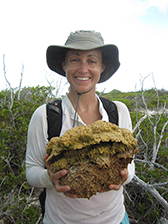Maya Gomes
Maya Gomes is an Assistant Professor of Earth and Planetary Sciences at Johns Hopkins University. She uses the sulfur cycle as a window into exploring biogeochemical cycling and microbial ecology in both modern and ancient systems with the ultimate goal of evaluating environmental drivers of major Earth-life transitions. For example, she has used models of water column biogeochemistry in modern lakes to explore how isotope records provide information about environmental changes associated with Ocean Anoxic Events and other mass extinctions. Although much of her work is centered around exploring how modern systems can be used to explore environmental change in the past, her research also provides insight into how climate change will influence biogeochemical cycling and ecosystem resilience in future.
At Northwestern, Maya focused on biogeochemical cycling in low sulfate systems because marine sulfate levels were much lower than modern levels for most of Earth History. Her advisor, Matthew Hurtgen, encouraged her to work in both modern and ancient systems to probe important questions about how to use sulfur isotope geochemistry to extract paleoenvironmental information from the rock record. She also benefited from research and career insight from her committee members: Bradley Sageman, Neil Blair, Abe Lerman, Donna Jurdy, and Francesca McInerney.
After completing her Ph.D, she expanded her studies of sulfur isotope geochemistry to include oxygen isotopes in sulfate as a NASA Astrobiology Postdoctoral Fellow at Harvard University. Then, she became a Postdoctoral Research Fellow in Environmental Studies at Washington University, where she undertook studies of geochemical and morphological signatures in modern microbial mats to inform the interpretation of biosignatures in lithified microbial mats deposited before the dawn of animal life. Now a professor at Johns Hopkins, she is developing a research group in Comparative Geobiology, which is a multi-disciplinary approach to study how geochemical and morphological patterns in modern sedimentary systems capture information about ecological diversity, biological activity, and environmental conditions.
When not thinking about sulfur, sediment, and rocks, Maya enjoys cooking, dancing, the outdoors, and various needle crafts. She keeps in contact with many people from Northwestern EPS and appreciates all of the support from this dynamic community.
